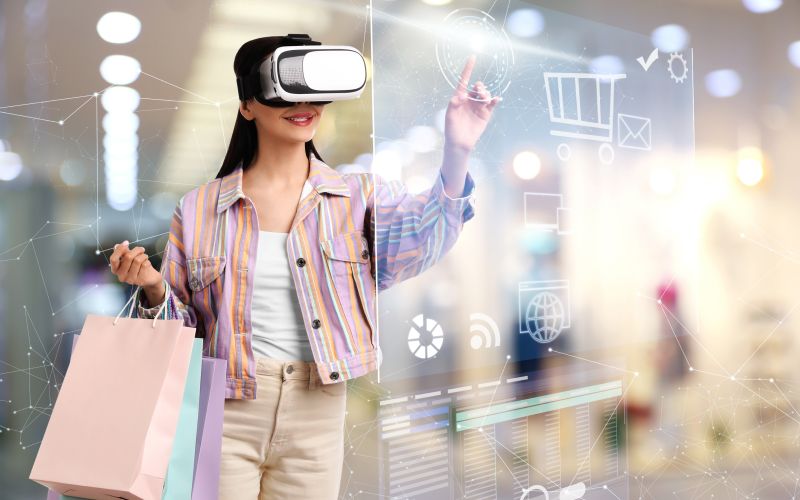Imagine walking down a bustling street in your favorite city, seeing not only the buildings, people, and cars around you but also an array of immersive and interactive digital content. A digital billboard displaying a trendy fashion show comes to life as you walk by, allowing you to zoom in on the intricate details of a dress that catches your eye. You’re able to virtually try on that dress and, if it suits your style, you make the purchase in seconds, with just a glance. This is the power of extended reality (XR) promised by Apple’s newly unveiled headset, the Vision Pro, and it’s a future the fashion industry cannot afford to ignore.
The Vision Pro and Its Impact
Last Monday, Apple made waves in the tech industry with the introduction of its Vision Pro, an augmented reality (AR) headset designed to blend the physical and digital worlds. This cutting-edge device, priced at $3,499, is controlled by the user’s eye and hand movements, voice, and a small dial on the device, eliminating the need for a remote. Tim Cook, Apple’s CEO, described the Vision Pro as a “wearable spatial computer” that allows users to interact with digital content as though it’s part of their physical environment.
Also Read: Apple Vision Pro: A Revolutionary Leap into Augmented Reality and Virtual Reality
The introduction of the Vision Pro isn’t just about pushing the boundaries of technology; it’s about defining the future of computing and the content ecosystem that will surround it. From gaming and film to productivity and educational tools, numerous industries have natural use-cases for this technology. However, one industry that stands at an intriguing crossroads with the advent of the Vision Pro is fashion.
The Fashion Industry and Extended Reality
The fashion industry, like any other, is continually evolving, embracing technological advancements to enhance its offerings. From online retail platforms to virtual fitting rooms, technology has allowed the fashion industry to break barriers and reach consumers in unprecedented ways. Now, with the arrival of extended reality through Apple’s Vision Pro, the fashion industry has another leap to take.
Imagine a shopping experience that includes a personal shopper and a product assortment displayed throughout your field of vision, instead of on a rectangular screen. Or the ability to twist and turn life-sized 3D products within your own environment, giving a whole new dimension to the phrase ‘try before you buy.’ These are just a few potential applications of extended reality in the fashion world.
And it’s not just about the consumers. Fashion designers can use this technology to design and preview their creations in a three-dimensional space, allowing them to visualize their designs in real-world contexts. Similarly, fashion shows and other storytelling moments can be broadcast in more immersive and interactive ways, offering audiences a front-row experience no matter where they are.
The Potential and Challenges Ahead
As exciting as these possibilities are, it’s important to note that they’re currently more speculative than definitive. During the presentation, Apple did not mention any specific capabilities for the Vision Pro that pertain directly to fashion, such as the ability to detect people and dress them in digital clothing, or overlay digital content into existing buildings. That’s not to say such features won’t be introduced down the line, but it does mean the fashion industry will need to explore and innovate within the framework of the technology as it currently exists.
Moreover, while the Vision Pro represents a significant advancement in AR technology, it’s worth noting that this is not the first foray into this arena. Other tech giants, including Meta, Amazon, Snapchat, and Microsoft, have released their own versions of AR and virtual reality (VR) technologies with varying degrees of success. However, none have truly broken through in terms of widespread consumer adoption.
So, why might it be different this time? Well, Apple has a track record of refining technologies and packaging them into desirable, user-friendly products, as seen with the iPod, iPhone, and iPad. It’s betting that the Vision Pro can succeed where others have failed, and in doing so, redefine our relationship with computers.
Implications for the Fashion Industry
Apple’s announcement also hinted at a potential new frontier for the fashion industry. The blending of physical and digital realities could revolutionize the industry by making digital clothing mainstream. Imagine trying on clothes in a virtual store, or altering your appearance on the fly with digital accessories. Fashion, by its very nature, is about expression and identity, and extended reality offers a whole new canvas for those expressions to come to life.
There’s a world of potential in the overlap of fashion and technology, but it won’t come without its challenges. From technological hurdles to consumer acceptance, the path forward is full of unknowns. However, the potential benefits – in terms of creative possibilities, consumer engagement, and ultimately sales – are too substantial to ignore.
This is why the fashion industry can’t ignore extended reality. As we stand on the precipice of a new digital frontier, it’s clear that those willing to take the leap will have the most to gain. The Apple Vision Pro is a bold step into that future, and it may just be the spark that sets the fashion world ablaze.
In the end, Apple’s Vision Pro isn’t just a new product; it’s a vision of the future. And in this future, fashion doesn’t just exist; it thrives in new and exciting ways that we’re just beginning to imagine.
The only question that remains is: are we ready to embrace it?















